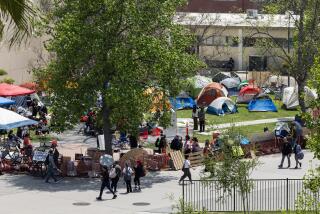DWP’s Response to Leak Leaves Residents Steaming
When Stephen Nahmias and his neighbors saw all that clear, cool water gushing down the street past their thirsty brown lawns, they practically salivated. “I’d be really happy if we could get that water up on my lawn,” Nahmias joked.
But when the leaking water line in the middle of the 1000 block of South Hayworth Avenue continued spewing a river the third day after residents reported the problem to the Department of Water and Power, the covetous looks turned to scowls.
“This is an appalling situation,” said Nahmias, a stockbroker who owns one of the neat Spanish-style duplexes that flank the Mid-Wilshire area street. The waste was especially egregious, he said, given drought-ridden Southern California’s ongoing battle for water conservation.
Nahmias and his conservation-minded neighbors have stopped watering lawns, hired plumbers to patch leaky pipes and reduced the water flow in showers and toilets to save water, he said.
“It rubs a really raw nerve at this point,” he said of the thousands of gallons of water he and his neighbors watched flow down storm drains.
But to the DWP, it was just one of those things.
According to DWP officials, the work crew that checked the leak Monday evening--and did not return until Wednesday afternoon--correctly assessed it as less than a top priority. There were at least half a dozen more substantial water leaks each day this week, including several broken mains, in the department’s western district alone, said Larry McReynolds, the engineer in charge of DWP’s water operating division.
“We’re going to have a number of small leaks that we won’t be able to respond to quickly enough to satisfy everyone,” said McReynolds, adding that the Los Angeles system is plagued by deteriorating water lines and meters built in pre-World War II years. Despite the department’s programs to replace tens of thousands of outdated meters and more than a hundred miles of water line each year, the system still suffers from a high rate of leaks each summer and winter because of the temperature extremes, he said.
Water officials estimate that the DWP loses 8% of its water, or 1.8 billion gallons annually, through leaks, evaporation and faulty meters.
Although the department’s efforts have reduced the number of leaks in the system over the years, McReynolds said that growing public awareness of the drought and the need for water conservation have nearly doubled the number of calls from residents reporting leaks and other water waste to DWP.
The increased awareness has led to increased frustration, as well, said McReynolds. “The public expects us to correct problems overnight--especially since we’re the ones urging conservation,” he said. But that’s not always possible, he said, noting that high-priority leaks usually take from one to two days to repair. Lower-priority leaks, such as the one on Hayworth Avenue, can take even longer.
But because of the amount of work involved in repairing even low-priority leaks, crews--like the one sent to Hayworth Avenue--sometimes leave without even starting the repair work.
While personnel have been reassigned from other duties to increase the number of leak-repair crews in operation during the busy summer months, McReynolds said that it would not be cost effective to hire additional workers to deal with the leaks. The water loss is minor, he added, compared to the district’s total water consumption.
Try telling that to Stephen Nahmias and his neighbors. On Wednesday--two days after they reported the leak on their street to DWP--Nahmias’ question remained: “Where the hell are they and why isn’t anybody at least patching the leak to stop the water flow?”
DWP work crews sealed the leaking water line later that afternoon, after a Times reporter called to inquire about the matter. McReynolds said the repair had been scheduled for that afternoon since Monday.
More to Read
Start your day right
Sign up for Essential California for news, features and recommendations from the L.A. Times and beyond in your inbox six days a week.
You may occasionally receive promotional content from the Los Angeles Times.






